History
The division was established on 1 December 1944 and was also known as the 1st Infantry Division of the Russian Liberation Army. The division was built up in Münsingen and was formally part of the Ersatzheer, the reserve army of the Wehrmacht, during the build-up period. On 28 January 1945, when construction was completed, the command was handed over to the Committee for the Liberation of the Peoples of Russia (KONR), which was granted the status of ally. In Andrei Vlasov, the army of the KONR, the VS KONR, had its own commander-in-chief and thus an independent position with regard to the Wehrmacht.
The core of the division was formed by remnants of the abolished 29th Russian SS Waffen-Grenadier-Division and 30th Russian SS Waffen-Grenadier-Division. This was supplemented by thirteen Russian battalions of the Wehrmacht and a large number of former prisoners of war and forced laborers. At full strength, the division had 18,000 men and was equipped with, among other things, a number of T-34 tanks, Jagdpanzer 38(t) tank hunters, a few armored vehicles and various types of artillery guns.
As a fire baptism, a small detachment from the 1st Division was successfully deployed in February 1945 against Soviet troops at Neulewin on the Oder. In March the entire division was moved to the Oderfront, where the Red Army threatened to break through. At the beginning of April the division arrived in the area of Heeresgruppe Weichsel, where it launched an attack on the Red Army at Erlenhof on 13 April, supported by the VS-KONR air force. When the attack got stuck within a few hours and the division had lost about 370 men, division commander Sergei Bunyachenko decided to move south, to the area between Linz and Budweis, where Vlasov wanted to concentrate his troops.
At the beginning of May the division stopped in the Czech city of Kozojedy, about 50 kilometers east of Prague. Here, Bunyachenko was approached by representatives of the Czech resistance, who prepared an uprising in Prague to expel the Germans from the city. The uprising broke out on May 5 and was assisted by the 1st Division the next day without the knowledge of Vlasov. In the fighting with German troops, around 300 soldiers from the division were killed. Although thanks to the Russians most of the city could be freed, their help aroused the anger of the Czech Communists, who demanded that they surrender to the Red Army.
On May 7, the division withdrew westward from Prague. The next day Germany capitulated. The division finally tried to surrender to the Americans, who, in spite of international law, extradited the Russians to the Soviet Union, where the soldiers ended up in Gulag camps. Bunyachenko was hanged after a sham trial, just like the other KONR leaders, on 1 August 1946.

The Waffen-SS was the combat branch of the Nazi Party's paramilitary Schutzstaffel (SS) organisation. Its formations included men from Nazi Germany, along with volunteers and conscripts from both occupied and unoccupied lands.

Andrey Andreyevich Vlasov was a Soviet Red Army general and collaborator with Germany. During the Axis-Soviet campaigns of World War II he fought (1941–1942) against the Wehrmacht in the Battle of Moscow and later was captured attempting to lift the siege of Leningrad. After his capture he defected to Germany and headed the Russian Liberation Army. Initially this army existed only on paper and was used by Germans to goad Red Army troops to surrender; only in 1944 did Heinrich Himmler, aware of Germany's shortage of manpower, arrange for Vlasov to form a real collaborationist army formed from Soviet prisoners of war. At the war's end, Vlasov changed sides again and ordered the ROA to aid the May 1945 Prague uprising against the Germans. He and the ROA then tried to escape to the Western Front, but were captured by Soviet forces with the United States' assistance. Vlasov was tortured, tried for treason, and hanged.

The Russian Liberation Army was a collaborationist formation, primarily composed of Russians, that fought under German command during World War II. The army was led by Andrey Vlasov, a Red Army general who had defected, and members of the army are often referred to as Vlasovtsy (Власовцы). In 1944, it became known as the Armed Forces of the Committee for the Liberation of the Peoples of Russia.

The Prague offensive was the last major military operation of World War II in Europe. The offensive was fought on the Eastern Front from 6 May to 11 May 1945. Fought concurrently with the Prague uprising, the offensive significantly helped the liberation of Czechoslovakia in 1945. The offensive was one of the last engagements of World War II in Europe and continued after Nazi Germany's unconditional capitulation on 8/9 May.
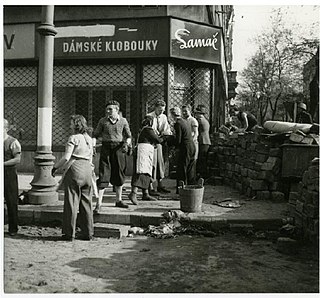
The Prague uprising was a partially successful attempt by the Czech resistance movement to liberate the city of Prague from German occupation in May 1945, during the end of World War II. The preceding six years of occupation had fuelled anti-German sentiment and the rapid advance of Allied forces from the Red Army and the United States Army offered the resistance a chance of success.

The 25th Waffen Grenadier Division of the SS "Hunyadi" was a short-lived infantry division of the Waffen-SS, an armed branch of the German Nazi Party that served alongside but was never formally part of the Wehrmacht during World War II. Established in November 1944 following the German overthrow of the Hungarian regime of Miklós Horthy, it consisted mainly of troops drawn from the Royal Hungarian Army's 13th Honvéd Division. It was never properly formed, trained, or equipped, and after being evacuated from its training camp in the face of the advancing Soviet Red Army, it surrendered to the United States Army in Austria in May 1945.

Kaminski Brigade, also known as Waffen-Sturm-Brigade RONA, was a collaborationist formation composed of Russian nationals from the territory of the Lokot Autonomy in Axis-occupied areas of the RSFSR, Soviet Union on the Eastern Front.

Ukrainian National Army (UNA) was a World War II Ukrainian military group, created on March 17, 1945, in the town of Weimar, Nazi Germany, and subordinate to Ukrainian National Committee.

The Ukrainian Liberation Army was an umbrella organization created in 1943, providing collective name for all Ukrainian units serving with the German Army during World War II. A single formation by that name did not exist. The designation was used by Ukrainian nationalists in reference to a number of companies and local Ostbataillonen of Hiwi volunteers desiring to free their own territories from the Soviet rule. They included enlisted Ukrainian prisoners of war (POWs) of the Red Army. The core of the Liberation Army wearing the УВВ sleeve badge originated from the 14th Waffen Grenadier Division of the SS reorganized in April 1945 into the Ukrainian National Army (UNA) active until the German surrender in May 1945.
Vladimir Ilyich Boyarsky was a Soviet Red Army officer who became a collaborator with Nazi Germany during World War II, serving in Andrey Vlasov's Russian Liberation Army.
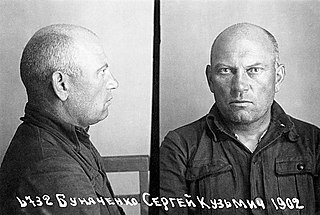
Sergei Kuzmich Bunyachenko was a Soviet Red Army defector to the German side during World War II and a major general in the collaborationist Russian Liberation Army (ROA). He was convicted of treason and hanged in 1946.

The 15th Infantry Division was an infantry division of the German Army during the interwar period and World War II, active from 1934 to 1945.
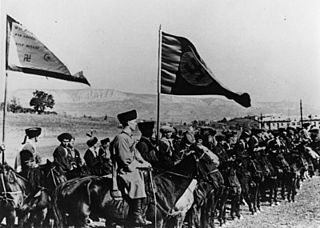
A large number of Soviet citizens of various ethnicities collaborated with Nazi Germany during World War II. It is estimated that the number of Soviet collaborators with the Nazi German military was around 1 million.
The 244th Infantry Division was an infantry division of the German army in World War II.
Fyodor Ivanovich Truhin was a Soviet major general during World War II. Following his capture during the Baltic Operation he defected to Nazi Germany becoming a leading member of the Committee for the Liberation of the Peoples of Russia and the National Alliance of Russian Solidarists. In the aftermath of the German defeat he was captured by pro-Soviet Czech partisans, who in turn transferred him to the Soviet Union where he was executed for treason.

The 650th (Russian) Infantry Division was a military division that was formed by the German Army during the Second World War. It drew its men mainly from Russian prisoners of war.
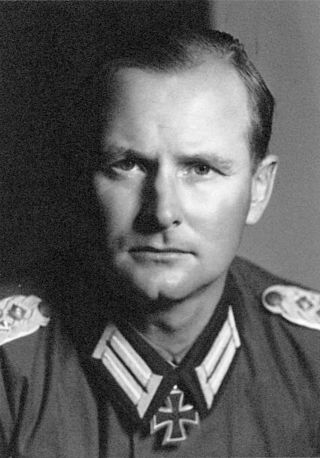
The Infantry Division Ulrich von Hutten was an infantry division of the German Wehrmacht during World War II, comprising the Army (Heer), Navy (Kriegsmarine), and Air Force (Luftwaffe). The Wehrmacht had numerous divisions, including infantry, armored, and other specialized units, which were involved in various military campaigns throughout the war. It was formed at the end of March 1945, just over a month before the end of the war. The division was named after German Protestant reformer Ulrich von Hutten (1488–1523).
The 270th Infantry Division was an infantry division of the German Heer during World War II.
Operation Cowboy was fought in the Czechoslovakian village of Hostau, on 28 April 1945, in the last days of fighting in the European Theater of World War II. It is one of two known incidents during the war in which Americans and Germans of the Wehrmacht fought side by side against the Waffen-SS, the other being the Battle of Castle Itter.
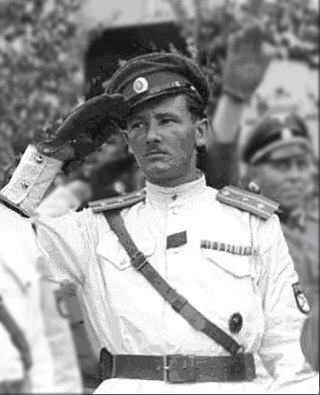
Igor Konstantinovich Sakharov was a Russian White émigré and collaborator with Nazi Germany during World War II. A foreign volunteer for the Nationalist faction in the Spanish Civil War, he later became one of the leaders of the collaborationist Russian National People's Army (RNNA) unit. Following the dissolution of the RNNA, he joined the Russian Liberation Army, partaking in the Prague uprising. After the war, he fled to Australia, where he died in a car crash.















